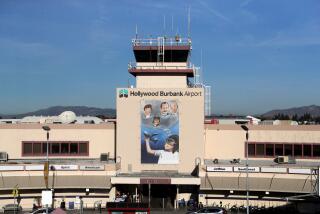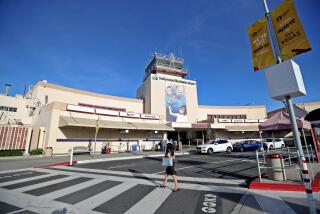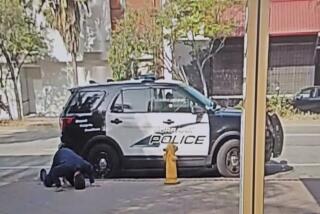Airport Panel Will Ask FAA to Clarify Requests
The Burbank Airport Authority has decided to ask the Federal Aviation Administration to further explain a package of safety requests that the president of the authority has warned could close the airport.
Members of the authority voted unanimously at their regular meeting last week to ask the FAA for âclarification of the matters set forthâ in a letter received in February.
In the letter, the FAA requested an immediate ban on jetliner takeoffs to the east from one of the airportâs two runways. The letter also included a request for elimination of 1,400 of the airportâs 3,200 auto parking spaces to create more room for airliners to load and unload passengers. The request poses serious financial problems for the airport, which takes a large portion of its income from parking fees.
Warning in 1980
The FAA also said it disapproves of any moves to increase commercial service until the authority submits a plan to replace the 55-year-old passenger terminal. The FAA warned the airport in 1980 that the terminal does not meet modern safety standards because it is too close to runways.
Robert W. Garcin, president of the Burbank-Glendale-Pasadena Airport Authority, had warned earlier that the airport âis in danger of effectively terminating its activitiesâ because of the difficulty of meeting the FAA requests.
Garcin said the request by the authority for an explanation was not a move to stall for time, but an attempt to secure âclarification of ambiguous areas, and areas that are inconsistent with what we believed was FAA policy.â
The objection to adding new airlines âappears to put a cap on services,â which is contrary to the FAAâs policy in the past, Garcin said.
Previous Stance
The request for the airport authority to ban jetliner takeoffs to the east goes against the FAAâs previous stance that the FAA and airline pilots have sole authority over flight operations, whereas airport operators control ground facilities, Garcin said.
âWe donât have the authority to enact that kind of restriction,â Garcin said. The authority will inform the FAA that it will enforce an FAA ban but cannot enact such a rule on its own, he said.
The ban on eastbound takeoffs is not in effect. However, airline pilots, who have the final voice in such a decision, rarely take off toward the east anyway, airport spokesman Victor Gill said. Fewer than 5% of airline takeoffs are eastbound.
At least 90% of commercial takeoffs are toward the south and on the other runway, which is 828 feet longer. That runway usually has more favorable wind and has a slight downhill slope toward the south, making it easier for a plane to reach takeoff speed.
The loss of the parking spaces would create a serious financial problem for Burbank Airport, which makes more money from passenger parking fees than it does from any other single source.
Millions in Revenue
Last year, when revenues totaled $11 million, the airport took in more than $4.2 million in parking fees. By contrast, $1.5 million in landing fees was collected from airlines and $2.7 million was received in rent from firms that do business on the airfield.
The parking spaces that the FAA wants removed generated $1.7 million last year, the authority said.
Besides aggravating a parking shortage, removal of the parking spaces would force the authority to recover the lost income from airlines that use the airport, Gill said. If an increase in fees caused the airlines to cancel flights at Burbank, âthen weâd be left with more parking spaces for airliners, but no airliners to put on them,â he said.
The FAA wants to convert the auto parking space to loading zones for jetliners so that passengers boarding and leaving planes will be farther from the runways.
Chief Objection
The FAAâs major objection to the existing Burbank Airport layout is the location of the terminal building. FAA regulations require a 750-foot safety zone between a terminal and the center line of the closest runway. At some points, the existing terminal is only 313 feet from the runway.
The airport has been operating on a waiver of the regulation, granted by the FAA on the condition that the authority build a new terminal.
A ruling by the Defense Department in December forced the airport authority to abandon plans, which had been under development for five years, to build a new terminal on land owned by Lockheed Corp. The federal government ruled that the site, on the east side of the airport, was too close to the âSkunk Works,â where Lockheed engineers work on highly secret military projects.
Members of the airport authority said they hoped to have at least a preliminary study of new terminal sites under way by early April.
Dr. Ellis Jones, a member of the airport authority, said the letter to the FAA should try to clarify the authorityâs maneuvering room with âsome simple sentence, like, âif we pick a terminal site pretty soon, will you guys back off?â â
The FAA action was one of two blows the airport suffered within a four-day period last month. The other was a Feb. 24 ruling by the U.S. Supreme Court, refusing to hear Burbank Airportâs appeal of a decision by the California Supreme Court in a noise damage suit. Failure of the appeal raises the possibility of a stream of such damage suits against the airport.
Burbank Airport administrators and officials of other municipally owned airports are hoping the state Legislature will pass laws limiting suits.
More to Read
Sign up for Essential California
The most important California stories and recommendations in your inbox every morning.
You may occasionally receive promotional content from the Los Angeles Times.










